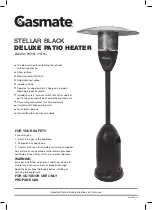
7
will allow you, the owner, to make choices that fit your travel
needs.
When loading your cargo, be sure it is distributed evenly to
prevent overloading front to back and side to side. Heavy
items should be placed low and as close to the axle positions
as reasonable. Too many items on one side may overload
a tire. The best way to know the actual weight of the vehicle
is to weigh it at a public scale. Talk to your dealer to discuss
the weighing methods needed to capture the various weights
related to the trailer. This would include the weight empty or
unloaded, weights per axle, wheel, hitch or king-pin, and total
weight.
Excessive loads and / or underinflation cause tire overloading
and, as a result, abnormal tire flexing occurs. This situation
can generate an excessive amount of heat within the tire.
Excessive heat may lead to tire failure. It is the air pressure
that enables a tire to support the load, so proper inflation
is critical. The proper air pressure may be found on the
certification / VIN label and/or on the Tire Placard. This value
should never exceed the maximum cold inflation pressure
stamped on the tire.
1.1 Trailers 10,000 Pounds (4536 kg) GVWR or less
(1) Locate the statement “The weight of cargo should never
exceed XXX kg or XXX lbs.” on your vehicle’s placard.
(2) This figure equals the available amount of cargo and
luggage load capacity.
(3) Determine the combined weight of luggage and cargo
being loaded on the vehicle. That weight may not safely
exceed the available cargo and luggage load capacity.
1.2 Trailers over 10,000 Pounds (4536 kg) GVWR
(NOTICE: These trailers are not required to have a tire
information placard on the vehicle.)
(1) Determine the empty weight of your trailer by weighing the
trailer using a public scale or other means. This step does not
have to be repeated.
(2) Locate the GWVR of the trailer on your trailer’s VIN
(Certification) label.
(3) Subtract the empty weight of your trailer from the GVWR
stated on the VIN label. That weight is the maximum available
cargo capacity of the trailer and may not be safety exceeded.
2. Steps for Determining Correct Load Limit—Tow
Vehicle
(1) Locate the statement “The combined weight of occupants
and cargo should never exceed XXX kg or XXX lbs.” on your
vehicle’s placard.
(2) Determine the combined weight of the driver and
passengers that will be riding in your vehicle.
(3) Subtract the combined weight of the driver and
passengers from XXX kg or XXX lbs.
(4) The resulting figure equals the available amount of cargo
and luggage load capacity. For example, if the ‘‘XXX’’ amount
equals 1400 lbs. and there will be five 150 lb passengers in
your vehicle, the amount of available cargo and luggage load
capacity is 650 lbs. (1400–750 (5 × 150) = 650 lbs.)
(5) Determine the combined weight of luggage and cargo
being loaded on the vehicle. That weight may not safely
exceed the available cargo and luggage load capacity
calculated in Step 4.
(6) If your vehicle will be towing a trailer, load from your trailer
will be transferred to your vehicle. Consult the tow vehicle’s
manual to determine how this reduces the available cargo
and luggage load capacity of your vehicle.
3. Glossary of Tire Terminology
Accessory weight
means the combined weight (in excess
of those standard items which may be replaced) of automatic
transmission, power steering, power brakes, power windows,
power seats, radio, and heater, to the extent that these items
are available as factory-installed equipment (whether installed
or not).
Bead
means the part of the tire that is made of steel wires,
wrapped or reinforced by ply cords and that is shaped to fit
the rim.
Bead
separation
means a breakdown of the bond between
components in the bead.
Bias ply tire
means a pneumatic tire in which the ply
cords that extend to the beads are laid at alternate angles
substantially less than 90 degrees to the centerline of the
tread.
Carcass
means the tire structure, except tread and sidewall
rubber which, when inflated, bears the load.
Chunking
means the breaking away of pieces of the tread or
sidewall.
Cord
means the strands forming the plies in the tire.
Cord separation
means the parting of cords from adjacent
rubber compounds.
Cracking
means any parting within the tread, sidewall, or
inner liner of the tire extending to cord material.
Curb weight
means the weight of a motor vehicle with
standard equipment including the maximum capacity of fuel,
oil, and coolant, and, if so equipped, air conditioning and
additional weight optional engine.
Cold inflation pressure
means the tire pressure when the
vehicle hasn’t been driven for at least three hours.
Extra load tire
means a tire designed to operate at higher
loads and higher inflation pressure than the corresponding
standard tire.
Groove
means the space between two adjacent tread ribs.
Gross Axle Weight Rating or GAWR
means the value
specified by the vehicle manufacturer as the load-carrying
capacity of a single axle system, as measured at the tire-
ground interfaces.
Not for
Reproduction








































